Archives
Does Your Water Taste Different?
Since the new Sydney Water desalination plant was commissioned January 28th 2010, we have had one of the hottest and yet wettest Sydney summers in recent years.
During this hot spell, we insisted that everyone on our plumbing service team, especially the plumbers out in the field, take water bottles and re-hydrate regularly.
Some of our team believe that the Sydney tap water is “different” since the desalination plant started mixing with our traditional water source.
I had to keep drinking to test the tap water, but, I think the water tastes a little “sweeter”.
Now “portable” water as our water supply is known to plumbing professionals, should be without:
- odour
- colour
- flavour
So we started to ask some of our clients what they thought, and we got different feedback from some of them.
Some, like me, said it is sweeter. Others reported the water was a different colour. Some even believed the new water supply had caused their taps and toilets to leak. Mind you, these comments were received whilst repairing those same leaking taps and leaking and running toilets.
So, is our water supply different? What are you mixing it with? Tell us what you think via the comments box.
As an incentive for the best Sydney Water story, I have 5 exotic Golf club caps to give away, courtesy of Champion Sports.
The US Masters begins next week Thursday April 8th – Sunday April 11th, 2010 in Augusta, Georgia, so post your comments by Friday April 16th, 2010 and the 5 best Water stories will be eligible to win a prize.
Oh and keep drinking water! We recommend it.
Blocked Drains…Minimise the Pain
If you have a history of blocked drains at your home, you should read the following to learn more about your drains.
Get a drainage diagram from Sydney Water and keep it handy; it’s part of your contract of sale.
- Tree roots will grow into your sewer, year in year out, through the joints in earthenware pipelines or where they meet PVC pipes. They will come back!
- Don’t ignore gurgling drains or siphoning pan outlets. They are a sure sign of a blockage.
- Investigate smells, they usually mean trouble.
- All plumbing fixtures, WC, basin, sink, bath, laundry tubs, kitchen sink etc. have an S or P trap, or water seal underneath. This trap is not to catch your diamonds (which we have successfully retrieved in the past), it is there to prevent the smell of the sewer coming into your home. If you have a bad smell in the bathroom or laundry it may be because the water seal in the floorwaste has dried out. This means the floorwaste is acting as a direct vent off the sewer and that’s why it smells. So an easy fix is to get a torch and see if the floorwaste is dry; if it is, get a bucket or jug of water, add disinfectant or bleach and tip it in. If the smell persists, it’s a job for the Lone Drainer and Pronto!
- Remove hair from your shower or bath drains. Bin it, burn it or flush it.
- Keep a simple sink plunger in your home tool kit.
- Don’t put sanitary products (tampons, napkins etc) or dental floss down the loo. Dental floss is like fishing line, very tough, it wont break down, it will cause a blockage!
- Only use toilet paper. Not tissues or newspaper. (Try the tissue-toilet paper test. Put them in a bucket and run water over them. See what happens).
- Toilet deodorisers that hang over the edge of your loo are not recommended! They fall in and no one wants to put gloves on and retrieve them, so they flush them down and guess what? They will help put a plumbers kid through uni!
- If you do hire an electric eel and try to clear a blockage yourself, exercise caution, they are a dangerous weapon in the hands of a novice and may cost you more money than you save!
If you need any help with this go to https://www.thelonedrainerandpronto.com.au/blocked-drains.html
Problems with hot water during the long hot summer?
Welcome to 2010!
Over the Christmas and New Year period we were called to rescue people with all sorts of plumbing emergencies!
Burst water pipes, blocked sewer drains, leaking taps and toilets are commonplace, but, here at the height of summer, calls for help for running hot water is at an all time high!
Ruptured water heaters or burst water heaters happen all the time and we only think of it as a problem in the winter, but we love a warm shower in the summer just as much.
Try telling a family that we can’t replace their particular type of heater over the holidays, because…………..ahhhhhhhh!
So here are a few simple tips that will assist:
1. Know where your water heater is. You would be surprised how many people don’t know where their water heater is!
2. Know how to turn your water heater off.
3. Try turning your water heater off to check that the cold water valve that turns it off works. One emergency water heater job we went to on Boxing Day, could have saved the owner money if they could have simply turned their heater off at the control valve or tap. The tap would not work, so we had to shut down the entire house, cut out the faulty tap valve and fit a new valve. We then turned the water to the house back on, so our clients at least had cold water to flush the toilet, make a cuppa and have a cold shower until we could track down the appropriate new water heater that was needed.
4. Pull the pressure relief valve on your mains pressure water heater, let it run for 5 or 10 seconds. When you let the valve go the water should slow down and then stop. If it does not stop, try it again. The pressure relief valve should be eased at least every 6 months.
5. Make sure its dry and clean around the base of your water heater storage area. Keep it clear of leaf debris, and long grass if it is outside.
6. Don’t store flammable liquids, petrol or paint anywhere near a gas water heater.
https://www.thelonedrainerandpronto.com.au/hot-water-services.html
Water or wine. Is there bacteria in water?
As Ben Franklin said; “In wine there is wisdom, in beer there is freedom, in water there is bacteria.”
In a number of carefully controlled trials, scientists have demonstrated that if we drink 1 litre of water each day, at the end of the year we would have absorbed more than 1 kilo of Escherichia coli, (E. Coli) – bacteria found in faeces.
In other words, we are consuming 1 kilo of poo..
However, We DO NOT run that risk when drinking wine & beer (or tequila, rum, whiskey or other liquor), because alcohol has to go through a purification process of boiling, filtering and or fermenting.
Remember:
Water = Poo, Wine = Health.
Therefore, it’s better to drink wine and talk stupid, than to drink water and be full of S _ _ t.
There is no need to thank me for this valuable information, thank my mate David Weekes.
I’m providing it as a public service!
I can’t turn my water meter off!
If you have a plumbing emergency, or you have water running all over your house, or a split tap washer, or burst water heater and your water meter won’t turn off, you may be in trouble!
If your meter tap has a tee-head on it, turn it off in a clockwise direction as firmly as you can. Firmly; don’t overdo it.
If your meter tap is missing the tee-head, get a large pair of grips and turn it off in a clockwise direction as firmly as you can. Firmly; don’t overdo it.
Open a garden tap to let out the pressure.
Then call an emergency plumber!
Check out this video below that shows what we do to upgrade your water meter control valve.
Great fun on a hot day!
Before a plumbing emergency arises ensure you know where and how to turn off your cold water supply. It’s incredibly simple if you know where it is.
I want you to have our plumbing Hints and Tips, they are free.
Simply fill in the box on our home page to get our Plumbing Hints and Tips.
I know they will help you in a plumbing emergency!
HELP! I’ve got a burst pipe in my bathroom!
This post is relevant to a Randwick plumbing emergency that happened yesterday.
We had an SOS from a long term client “Joan”.
You could hear the panic in her voice. “Come quickly, we have a burst water pipe under our vanity basin and we can’t turn the water off” screamed Joan.
“Is your floor waste drain clear?” we asked. “Yes” Joan replied!
We told her how to minimise the water damage by shutting the cupboard doors and direct the gushing water towards the floor drain, and then putting a towel across the doorway to keep the water flow in the bathroom.
We were at the house within 15 minutes, and with a large pair of grips, we were able to slow down, but not stop the water flow.
Now, a picture paints a thousand words and this short video will actually take you there.
Please watch and learn.
It’s incredibly simple to figure out where and how to turn off your hot water and cold water supply if you know where they are, and avert any plumbing emergency.
I want you to have our plumbing Hints and Tips, they are free. Simply fill in the box on our home page to get our Plumbing Hints and Tips.
I know they will save you thousands of dollars!
Stylish French @ Reims and Beaune Hotel
Sydney builder Steve Miller and his wife Carmel were on a working holiday in France and visited this beautiful hotel.
If you think your kitchen sink tap or mixer tap needs replacing or the gooseneck spout over your tubs is old, then check out this “Gooseneck” spout that made up the plumbing in the hotel kitchen sink.
Steve says it’s gold plated and still works beautifully.
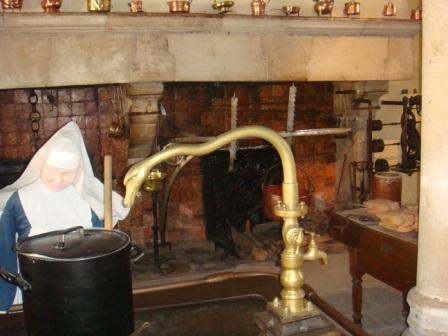

This image shows the magnificent detail on the hotels slate tiled roof. Steve was in awe of the skills used to create the turrets, dormers and finials that adorn the roof.
Being a plumber my interest was in the roof gutters made from lead, and well, there are no downpipes, only gutter outlets or “spitters” in the shape of a Gargoyle, that spat the roof rainwater out onto the gravel driveway.
The French are so classy!
https://www.thelonedrainerandpronto.com.au/plumbing-services.html
Holy S_ _t! A Gondoliers impressions
Today’s post comes courtesy of the World Famous Venetian Gondolier, my mate Giovanni Giudice.
I met Gio in the summer of 07 -08. He was visiting Australia, learning to surf and was escaping the Venetian winter because “business is slow”. Gio was staying in Coogee at the home of a client who funnily enough had a blocked drain. We hit it off straight away; I told him about places to visit along our beautiful coast and Gio in return told stories of the romantic city of Venice, Italy.
Invariably the conversation got back to blocked sewers and blocked drains and how different it would be to deal with a blocked drain in Venice, compared to being a Sydney plumber. Upon his return to Venice, Gio answered my question with a series of photos he took on the way to his gondola one morning.
Below are the photos he sent of a septic boat, pumping the waste from the Palace of the Bishop of Venice.
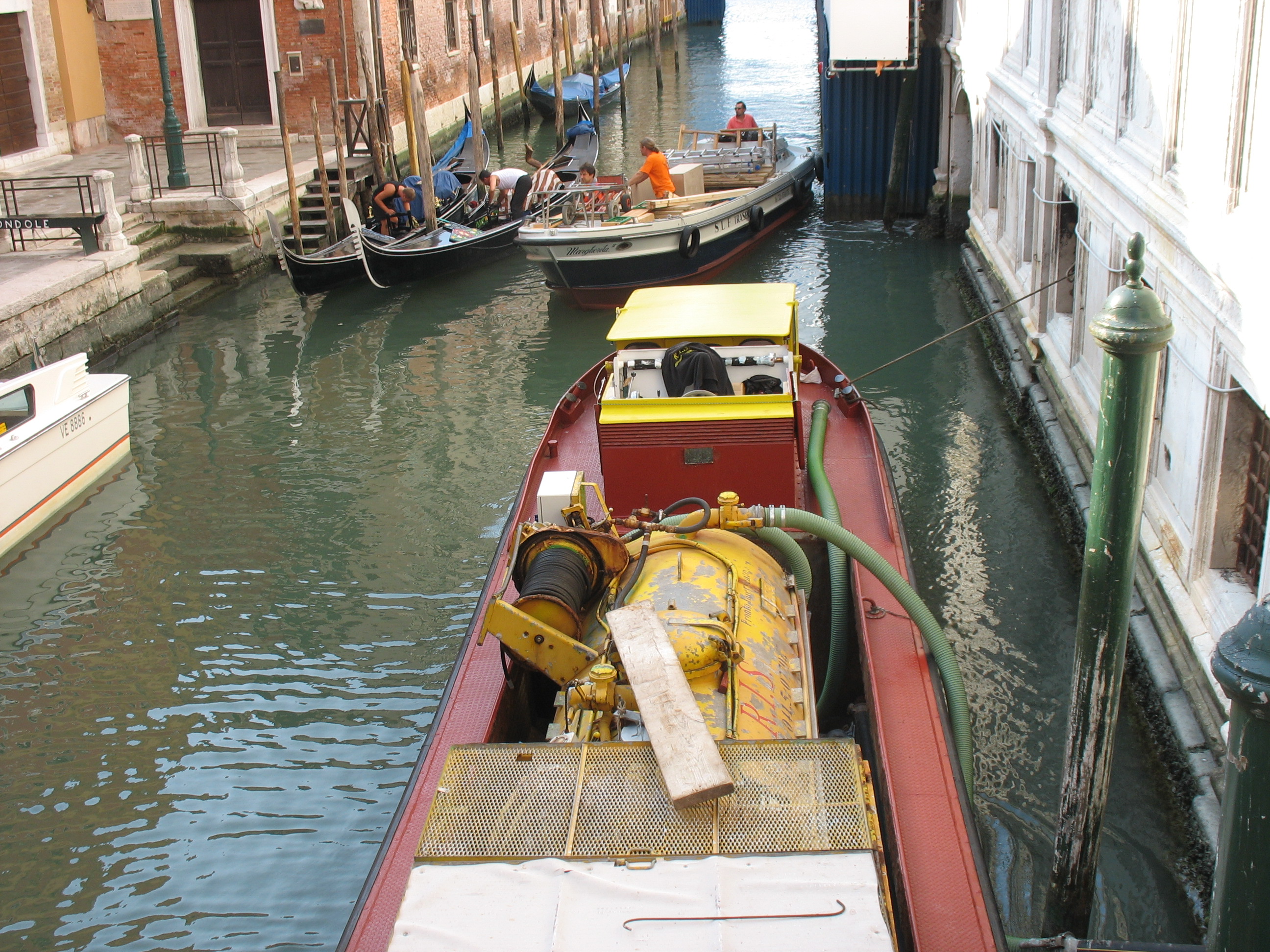
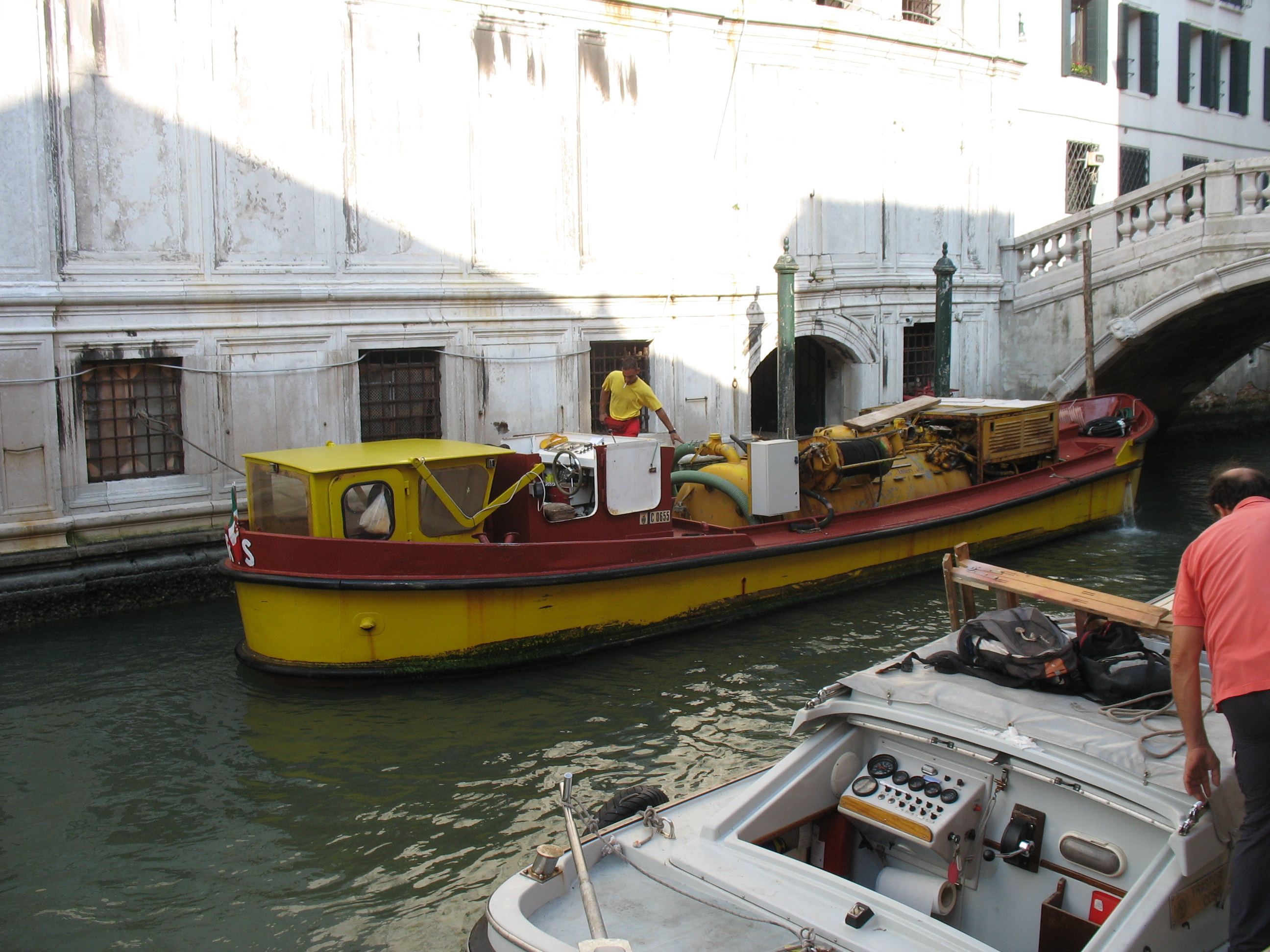
If any of our readers are lucky enough to be travelling to Venice, ask for Gio’s contact for the best gondola tour of that beautiful city.
Green Loans
Green Loans have been set up by the Australian Government in order to provide subsidised loans to assist in making houses more environmentally friendly. This is a great way to provide financial assistance to households to gain access to the resources they need to invest in energy and water efficient technologies, and hence reduce total greenhouse emissions from domestic households. After undertaking a free “home sustainability assessment”, owners or tenants of eligible homes are allowed to take out a loan of up to $10,000 at zero interest in order to make the changes suggested in the assessment.
The assessment is carried out by a qualified expert assessor and will provide advice from the smallest behaviour change to major investments such as photovoltaic panels or a solar hot water system which can be installed by your local plumber. The assessment itself is also completely free and should only take around 1.5 hours. While only one green loan can be made per assessment, this loan can be used to carry out a number of different projects.
Funding for these loans is obviously limited so those interested should act fast. If you would like to be considered for a loan, book a Sustainability Assessment by calling the hotline on – 1800 895 076.
More information is available at http://www.environment.gov.au/greenloans/
Are you Ready for Spring?
Spring is here and summer is just around the corner! This means footy finals, Spring Racing and cricket! You don’t have to change your sleep habits to watch the games, and you can start planning a good old BBQ with family and friends.
This also means that people will want to get their backyard into shape, and the NSW State Government is helping with this by offering rebates for some water saving devices. More information about this can be found at http://www.environment.nsw.gov.au/rebates/
Here are some simple ways to save water around the house but still keep your garden looking its best during the hot summer:
– Install a timer irrigation system. Drip lines are effective as they deliver water straight to the plant root system and largely avoid water loss through evaporation.
– Use mulch throughout your garden beds to further trim down evaporation.
– Install a trigger nozzle. They save water by shutting off a hose between watering different plants in the garden.
– Install a rainwater tank to capture otherwise wasted rain water that runs off the household roof. The NSW Government provides rebates of up to $1500 for such tanks.
– Think about installing rain and soil sensors which prevent irrigation systems from operating unnecessarily after rainfall.
Also if you are installing a new BBQ, always remember to use a licensed gasfitter!
Overlooked Grand Final Heroes – Plumbers!
With a crowd of nearly 100,000 spectators expected to cram the Melbourne Cricket Ground this Saturday for what is obviously one of the biggest annual sporting events in Australia, it puts a large burden on the grounds personnel and infrastructure.
The challenge includes the upkeep of the ground’s 546 urinal stalls, 166 individual urinals and 345 toilets. Whilst this may seem daunting, the 3.5 million people who annually pass through the MCG gates during the course of the season provide great training and testing for these bathroom facilities, and give plumbers and curators a great idea of whether or not the lavatories will be able to cope on the last weekend in September.
During the large scale redevelopment and rebuilding of stands at MCG earlier this decade, plumbing was also improved.
In recent years, improved crowd control and regulation has ended the outlandishly large crowds on Grand Final Day, such as the enormous 121,696 people who packed the MCG in the 1970 Collingwood v Carlton match. Although people may not drink as much at the football game as back then, facilities and maintenance practices today are still light-years ahead of what they were. This includes a team of plumbers outsourced by the grounds manager who must go to great lengths in preparation for a big event to ensure everything runs smoothly.
Whilst crowd satisfaction is the foremost goal at a large event, in the 21st century the sustainability of a venue must also be taken into account. One of the ways the MCG attempts to be more eco-friendly is by catching rainwater from the gigantic Northern Stand roof and storing it in a 1.5 million litre tank below gate one.
Even though it is very easy to forget about plumbing when at the footy, it is still amazing how much time, effort and planning must go into managing something as simple as bathrooms, in order for fans to have an enjoyable, comfortable and trouble free day.

Why you should ‘Dial Before You Dig’
Before carrying out any excavation for plumbing repairs, your licensed plumber should do a “Dial before you Dig” check on your property and surrounds.
This process shows where gas, water, sewer, stormwater, telecom and electric services owned by all utilities are located.
Although this is an extreme case, check out what could happen if you don’t know what lies beneath:
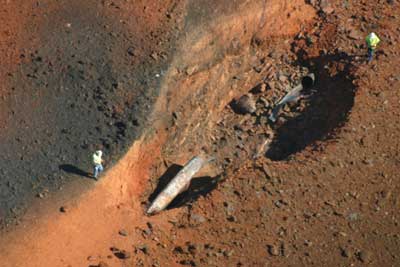
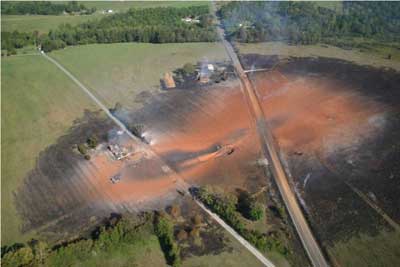
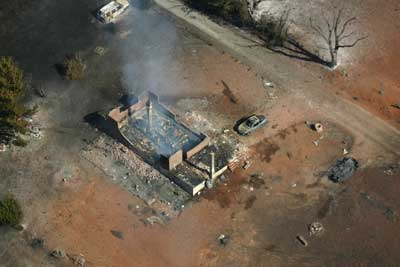
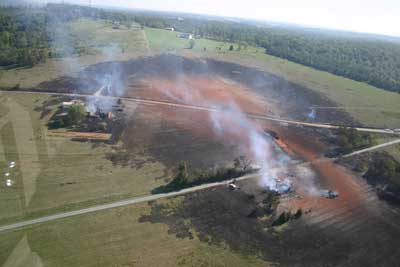
This massive explosion occurred in the USA during September 2008. Although it was caused by pipe corrosion, and not by a farmer digging as several emails have suggested, the extreme destruction seen in the photographs above shows the extensive damage that can be caused by an exploding gas pipe, and how obvious it is that this should be avoided at all costs.
If you’re not sure about the condition of your gas pipes, call a licensed plumber, and remember to always dial before you dig!
Aussie Bidet Toilet Seat
Recently The Lone Drainer and Pronto were called to repair a leaking toilet cistern in Bondi Junction. I was surprised to see this toilet not only had a flush button but came with a remote control as well. The client informed me that the toilet actually contained a bidet built into the toilet seat, complete with retracting heated water spout, air dryer, and instant seat heater, all of which are adjustable to suit individual comforts and anatomy. Whilst the bidet is a very popular plumbing fixture in Europe, by comparison, I have come across few during my many years of plumbing in Australia.
The bidet toilet seat is a compromise.
Whilst this can be deemed as a “luxury” item for most, our client revealed that a relative of theirs who has suffered a stroke also had a bidet toilet seat installed and with the loss of mobility in extremities after the stroke, this has proved to be of great assistance to them and their family when using the bathroom.
What a great idea! A bidet toilet seat could be of great assistance for the elderly, disabled, infirmed or even people with sports injuries.
http://www.TheLoneDrainerAndPronto.com.au/unmasked.php

Toilet Humour
A toilet is a plumbing fixture and disposal system primarily intended for the disposal of bodily wastes: urine and faecal matter. Additionally, vomit and menstrual waste is sometimes disposed in toilets in western societies.
The word “toilet” can be used to refer to the fixture itself or to the room containing the fixture, especially in British English. In Canadian English, the latter is euphemistically called a washroom, and in American English, a restroom or bathroom. The latter term usually refers to a room that also contains a bath tub. A room with only a toilet and a sink is sometimes called a half-bathroom or a powder room.
There are two basic types of toilets: the dry toilet, and the wet toilet – the latter being the most commonly known and producer of blackwater. The dry toilet needs no plumbing for water input or evacuation, but is often coupled with some ventilation system.
Humour
Humour or humor (see American and British English spelling differences) is the tendency of particular cognitive experiences to provoke laughter and provide amusement. Many theories exist about what humour is and what social function it serves. People of all ages and cultures respond to humour. The majority of people are able to be amused, to laugh or smile at something funny, and thus they are considered to have a “sense of humour.”
When attending to blocked drains we sometimes encounter “Toilet Humour”!
www.TheLoneDrainerAndPronto.com.au
Use only Genuine Pipes! for Plumbing
Today’s post is courtesy of Dr Marc Dussault. Check him out at:
http://www.ExponentialPrograms.com/business/blog
Piping Specifications
Mr. Santa Singh is a brilliant engineer of College of Engineering Patiala and Mr. Banta Singh is his boss and a gold medalist of Jalandhar University. Both of them are serving for Punjab Pipes whose owner is Ms. Gurujit Kaur. In one of the tenders Mr. Santa Singh has declared the pipe specifications.
Prepared by: SANTA SINGH Approved by: BANTA SINGH
NOTE: Some vendors are now able to supply pre-rusted pipes. If available in your area, this product is recommended, as it will save a great deal of time at the job site.
Danger of Gas Room Heaters
We opened the heater to have a good look inside and it appeared that the motor had overheated and had started to melt the casing. It was a disaster waiting to happen!
Fortunately there was a tradesman working next door who quickly came on the scene and disconnected the gas appliance from the gas supply, preventing a potential fire!
As the days get colder and we turn to our gas room heating appliances to keep us warm, please dust them and make sure you can disconnect them from your gas bayonet fittings with ease.

Dangerous gas room heater
What Happens When Tree Roots Grow In Sewer Pipes
The intrusion of tree roots in sewer pipes is probably the most destructive single element that faces those maintaining a sewer collection system today.
Sewers are ageing expensive assets that only attract public attention when they fail. There are more than 35,000 kms of water and sewer pipes in Sydney and 60% of all collection systems are made up of pipes with a diameter of 9 inches (225 mm) or smaller. The potential for tree root intrusion to inhibit flows, produce blocked drains and damage valuable pipes, is enormous.
Tree roots normally do not grow underwater and seldom cause problems where ground water covers the pipe. But in most areas, this is not the case.
Tree Roots Grow One Cell at a Time
When a seed germinates, it adds one cell at a time toward the best environment from which it might extract nutrients and moisture. The growing point of a tree moves best through loosely cultivated soil.
The most common practice used to lay sewer pipes is in an open trench. The back-filled soil offers a good growing medium for tree roots. Because the flow in sewer pipes is a higher temperature than the soil, this causes a condensation to appear on the crown of the pipe.
As the warm moisture from the sewer pipe evaporates up through the soil, the vapours offer an excellent trail for the tree roots to follow. If a vapour leak exists in the pipe, the roots concentrate its efforts at that point. Since some pipe joint compounds are of nutrient based material themselves (like rubber rings or sand cement mix), the root may entirely girdle before entering the pipe.
Roots Allow Accumulation of Debris
Once inside the sewer pipe, the root takes on the appearance of a “veil” or “horse tail” type structure. If flows in the pipes are fairly constant, the root mass hangs down like a veil to the normal flow level where they accumulate deposits of grease, slime and other debris.
Conventional methods of removing tree roots by cutting with an electric eel or a “Rattlesnake” high pressure water drain cleaner tend to increase regrowth; similar to pruning a tree. Removing tree roots inside the pipe solves the immediate problem of clearing the blocked drain, but does nothing to retard the tree root regrowth or destroy the tree roots outside the pipe.
This removal, regrowth and removal cycle of cutting and tearing roots can destroy the structural integrity of the pipe.
Herbicide Fumigants
Herbicide fumigants present the most effective method to destroy tree roots and inhibit their regrowth without affecting the above ground plant life. Vaporooter is a root control herbicide that enters the sewer as a foam. Only tree roots within the pipe and a short distance outside the pipe are affected. Trees and shrubs immediately above ground are not harmed in any way.
Plumbing Apprenticeship – ‘Giving back to the Community’
At The Lone Drainer and Pronto we like “Giving Back” to the community because the Plumbing industry has been very good to me and my family.
Every year around January we have anywhere from 5 to 20 boys (or their mothers) contact us inquiring about a plumbing apprenticeship. We have trained 9 apprentices in 20 years (plumbers apprenticeship is 4 years).
In early January we received the usual phone calls, letters and emails from people asking aboutplumbing apprenticeship. One day we received a call from a lady (she sounded late 40’s early 50’s) asking for a plumbing apprenticeship. I replied saying, “with the greatest respect, you sound a little old to be starting an apprenticeship.”
You could almost hear this lady blushing down the phone… She said, “I’m ringing for my son.” She told me all he ever wanted to be was a plumber! So we talked a little about her son and about his experience and she said he was very shy! I asked her to get him to ring and speak to me if he was keen about trying to develop the skills that he would need in his preferred occupation.
Three days later her son “Francis” rang and he told me how they had laughed about my quip about his mum being “a little old to start”. He sounded like a great kid and I invited him over to our office to talk. I showed him around our office, workshop and store and he was able to take a look at plumbing stuff, pipes and fittings. He loved the experience! I could not take him on at that time, but invited him to come back at his leisure and ask questions or check out anything about plumbing that he was interested in.
Francis came back twice over the next few weeks and about a month later, he rang me to say he had got an apprenticeship with a plumbing company near his home. He sounded completely different to the shy kid who got his mum to ring. He said he had the confidence to apply for a job because the things we had shown him, the pipes, the fittings, the equipment, the jargon, had given him enough confidence to get him over the line at another job interview.
He thanked me profusely.
I see Francis at local plumbing suppliers and he always has a smile and we have a chat. It’s great to know our industry will be in good hands in the future.
The distinction!
No matter how simple, always try to pass on the knowledge, educate and inform!
It’s like sowing a crop!
Plant the seeds … Add water and sunshine … Prepare for harvest.

